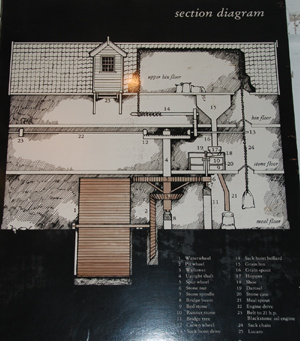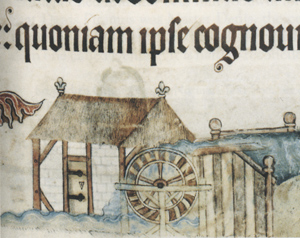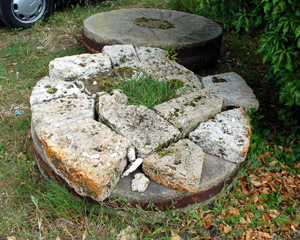 |
 |

|
Food and drink were the fundamental requirements of medieval life. Thus it is not surprising that the first forms of mass production were related to these requirements. Malting of barley for beer was an industry which existed before the common brewer came into being, and milling of grain to produce flour was the first form of food processing on a more than domestic scale. Nearly every village would have need of these facilities.
We are here concerned with mills and milling, and, in particular, with watermills. In pre-historic times, grain was ground in a quorn or quern, where an upper stone was either rubbed or rotated to crush the seeds against a lower stone. Later these millstones might be turned by horse or oxen, or even by slaves, and these methods survive in some parts of the world today. However, wheels driven by water also have an ancient origin, and were used for many purposes, but in England, the use of water for watermills seems to date from the 8th century. Records do not allow us to find any earlier examples. Watermills were widespread in Saxon England by 1066. By contrast the earliest known windmills in England do not occur until the 1180s.
|
 |
Types of Watermill At its simplest, power can be extracted from the flow of water by inserting a wheel into a flowing stream, which has some form of paddle or bucket arrangement to allow water to push the wheel around. In practice, water levels fluctuate with the weather and seasons, and the strength of flow also fluctuates. In addition it was quickly obvious that different wheel designs could affect the efficiency of the arrangements. So a watermill soon needed methods of bringing a reliable supply of water to the mill, while making arrangements for flood waters to by-pass the mill buildings. This usually involved a series of gates or sluices placed in the flow to regulate it, and a series of sluices to control the outflow of surplus water, and divert it around the mill. Arrangements would differ depending upon the topography of the locality. Some mills were placed on river banks, while others were set back from the main watercourse and used a leet or manmade millstream or ditch to feed water to the mill. Where the watersource was less than ideal, a millpond might be constructed, which accumulated a large head of water, which the miller would tap when he had grain to grind. Once the level dropped in the pond, milling would cease. The local topography might also help decide the type of wheel which was most suitable. On very flate sites, an undershot wheel might be the only practical solution. This is where the water flows below the wheel, pushing those paddles which were below its surface. This was the least efficient type of wheel. The best wheel was one where water could be fed to the top of the wheel, in an arrangement known as an over-shot wheel. This needed either a natural slope in the ground, or considerable groundworks to engineer. It rarely, if ever, was feasible in East Anglia. Less difficult to engineer was the breastshot wheel, where water was introduced at about three quarters of the way up the wheel. Other modified versions of this were called half breastshot, and low breastshot, and these were the most frequent in our area. Often, below the mill would be a millpool. This received the water after it had passed through the mill, and also received overflow water from the mill pond above the mill. Both millpond and mill pool, would be stocked with fish and eels, and regularly trapped for food. Mills actually situated on a river would do without a mill pond and mill pool. |
 |
Watermill history Watermills have been built in this country from the 8th century onwards. By 1066 they were already common, but the need for a reliable and plentiful source of water was a geographical limitation to their spread. These were constructed in wood, and hence very little evidence of them remains today. The earliest English windmill dates to the 1180s. By the 1190s there were 15 windmills known of in England, 9 of them in East Anglia. Windmills were cheaper to build than watermills, and spread rapidly over the 13th century. Watermills continued to have some advantages, however. This illustration from the Luttrell Psalter (c1325-1345) shows an overshot watermill with fish and eel traps in the millpond. Millers at Icklingham and Mildenhall continued to harvest eels for market right up to the 20th century. So, despite the popularity of the windmill, watermills continued to be built or rebuilt through until the 19th century, usually on or near the site of an existing watermill. It is these brick built 18th and 19th century buildings which survive today in some places, although many were demolished before 1939. |
 |
The millstones Traditionally, corn has been ground between two round millstones, one rotated over the other in the horizontal plane. The lower stone is called the "bedstone", and does not move. The upper rotating stone is called the "runner". This principle applied to hand grinding, rotation by animal power, water mills and wind mills alike. In the north of England, locally quarried millstone grit could be obtained in the Pennines. However, although these were cheaper than imported millstones, these imports were apparently preferred in East Anglia by the 14th and 15th centuries. Basalt lava stones were cut in the hills of the mid-Rhine region, and were in one piece. Ferries brought them down the Rhine from Cologne and they were shipped to ports like Kings Lynn, Ipswich and Yarmouth. St Edmund's abbey bought stones in each of these ports, depending upon availability and proximity to the mill in question.
By the 19th and 20th centuries, better iron working was available. Millstones could be made by wrapping several matching pieces within an iron band, saving cost and inconvenience. Imported French burr was the stone used in these millstones, the pieces cemented together with plaster of Paris, and bound with an iron hoop. French burr was still often preferred to Derbyshire millstone grit, especially for grinding wheat.
In East Anglia the dry climate meant that water mills were always at a disadvantage. In some places a windmill had been situated near to an existing watermill, and both might be operated by the same miller. This happened at Fornham St Martin. It was possible in these arrangements for the watermill to be working when there was no wind, and the windmill to work at times when water levels were too low for the watermill. So, perhaps surprisingly, several watermills survived into the First World War. However, alternative sources of power, together with the displacing of mill stones by steel roller mills, caused the inexorable decline of both wind and water mills.
Both wind and water were essentially "free" sources of power, so when steam engines came on the scene early in the 19th century, they were not immediately attractive. At around 1880 steam power was becoming viable for milling, meaning that mills were no longer tied to rivers or hilltops for wind. At the same time, cheap American grain began to flood the market after 1878. This imported grain was also much harder than English wheat and created a problem since the wind and watermills could not grind it.
A solution appeared in the form of the roller mill, a Hungarian invention, which could cope with hard North American wheat. These roller mills could easily produce much whiter flour than the old stone mills. The large milling companies set up mills on dockside sites as the most economic way of handling imported grain. Because roller mills could produce white flour much easier and cheaper than the millstone process, this made them much more profitable to operate. White flour was highly desirable at the time, as hitherto it was the preserve of the better off classes, who could afford the premium price paid for white bread.
The small inland mills would rapidly become less profitable and several would go out of business in the next twenty years after 1880. Nevertheless, some millers found ways to carry on. In April 1893, Parker's watermill at Icklingham was converted to use electric lighting. A generator was run off the waterwheel. It was the first flour mill in Suffolk to be lit by electricity. Parkers were also to rejuvenate a few local watermills by converting them to roller mills over the next few years.
Windmills and watermills all had a hard time during the Great War. During World War I, millers were forced by government regulations to grind only animal feed thus limiting their usefulness. The watermill at Chimney Mill closed down in 1916. It would be demolished in 1932. In 1930 the Pakenham watermill was sold to Mr Marriage, the owner of Bury St Edmunds' Southgate Windmill. Marriage had already installed a steam engine there to supplement the wind power, and in 1942 he installed a Blackstone oil engine and a roller mill kit at Pakenham to make white flour.
Despite these few survivors, most wind and water mills were defunct by 1920, overwhelmed by roller mills, white flour, and more reliable and by now cheaper, alternative power sources.
|
|
A History of the Abbey of Bury St Edmunds, 1182-1256 by Antonia Gransden, 2007 Information first prepared by David Addy, 15th July 2008
|
| Go to Watermills Homepage |
Page created 15th July 2008 Updated on 2nd September 2008 | Go to Main Home Page |